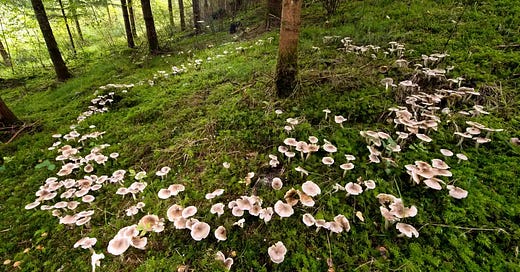The leafcutter ants of the South American tropics are perhaps the most successful organism on planet earth in terms of biomass. Look at the floor of the jungle and you will see long highways of ants hurriedly transporting leaf cuttings of all sizes.
But what's this? A single ant has broken away from her sisters to wander off the beaten path. She makes her way into the jungle to a spot about 10 inches off the ground with just the right amount of humidity and sunlight. But just right for who? No other ants are in sight. She has been hijacked.
The wayward ant chomps down on a leaf and stops, waiting for death. Several days after the ant has died, a long straight spike emerges from the back of its head. It is the fruiting body of the parasitic cordycep mushroom (yes the same cordyceps your bio-hacking friend has started putting in their tea) . It will release millions of spores into the area, so the ant zombie mushroom cycle may continue.
How do the cordyceps accomplish this crazy feat of mind control, creating zombie ants to spread their spores throughout the jungle? And how many more fungi are there like this?
Try not to get too creeped out, but the answer is we just don’t know. While there have been around 400 species of cordyceps identified, half of those were discovered in just the last 3 or 4 years as the interest in cordyceps as health supplements has exploded. This is the situation all over the world of fungi these days. Many new discoveries and growing interest, but still only scratching the surface of an ancient and mysterious world that connects every level of the vast tree of life.
Fungi are the great digesters and connectors of the earth’s ecosystems, recycling millions of tons of organic waste annually. While animals find food in the world and take it inside their body to digest it, fungi digest the world outside their bodies and absorb it into their bodies. This process usually involves growing branching tubes called hyphae that fill the soil in great interconnected webs. These interconnected webs, called mycelium, are capable of a great variety of feats including toxic waste processing, carbon sequestration, and even problem solving.
Problem solving by a mass of tubes with no organs, no brain, not even a neuron to speak of? How can this be? And what does it say about the limits of our understanding of intelligence that a creature so alien to our ideas about how problem solving works can be so adept at it? There is a burgeoning science around the information processing abilities of mycelium networks trying to answer this and many other questions. Fungi have a fascinating ability to communicate and to model and influence other creatures' behavior in ways that challenge even the human brain’s abilities. As author Merlin Sheldrake says, “Thinking about fungi makes the world look different.”
By now you may have heard of the Wood Wide Web, a popularized term for the Mycorrhizal networks beneath the forest floor acting as a kind of information network. Discovered and described only recently in a series of papers published by University of British Columbia professor, Suzanne Simard in the early 2010s, this groundbreaking theory is uncovering the massive role fungi play in connecting up the trees in a forest. These networks allow the trees to not only share carbon, water and nutrients with each other and the fungi, but also allow for communication between the trees across vast distances to alert one other about dangers and coordinate responses. Helping the forest ecosystem to act as a unified whole in the face of threats and crises.
Essentially, the mycelium network creates both the physical structure and the chemical signals allowing a kind of language to form for the forest to communicate with itself. This mysterious facility with language may help explain how some species like the cordyceps are able to take control of the brains of hosts and alter their behavior.
Controversial thinkers like Terrence McKenna, Daniel Pinchbeck, and Jeremy Lent theorize that fungi’s abilities to change minds played a role even in our own evolution, paving the way in our brains for our ancestors on the plains of Africa to build complex language, culture and religion via an early relationship with the hallucinogenic mushroom Psilocybe Cubensis. It is theorized that early hominids' use of these psychedelic mushrooms as a hunting aid blossomed into a whole new way of being with one another and the environment.
When the number of crises and existential risks we face number in the hundreds or even thousands, requiring just as many solutions, it can be difficult to find a way forward, to believe in a future where things are better, let alone not terribly worse. Which is why our growing interest and understanding of fungi and its ever present role as stewards and workers of the environment is so important and exciting. Fungi create the framework for cooperation and complexity that so much of our world is built upon. A more connected, more integrated approach is needed as an overarching solution to our many problems of disconnection and destruction. Our life-giving ecosystems are clearly too complex in their leaderless interdependencies to bend to the hierarchical, dominator approach of technologically mediated late stage capitalism. We are all ready and hoping for a new perspective, a new way of being at a time when so many find themselves isolated and separated from the natural world. Perhaps the kingdom of the fungi can offer that new way of being. It is exciting to see that a growing army of scientists and mushroom enthusiasts are working to uncover nature’s best kept secrets.



Admire your ability to take complex issues and illuminate them easily. Also appreciate the positive take on a possible future.